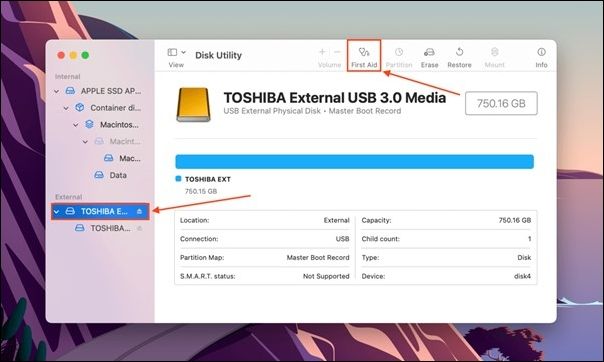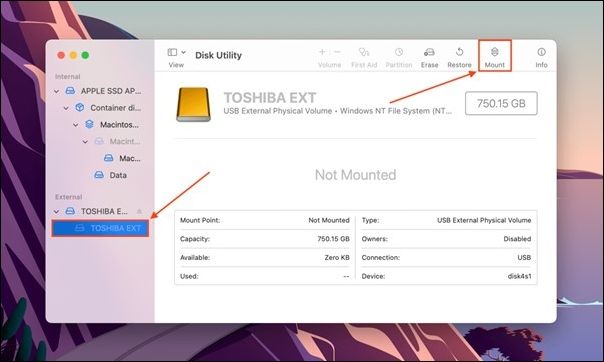The ability to effortlessly move and keep massive quantities of data has made portable external hard disks prevalent in modern life. However, it can be irritating and even cause worry when an external hard drive fails to install on a Mac, as we may have crucial data saved on it. When this happens, corrective measures must be taken immediately to restore data integrity and accessibility.
However, we've got you covered if you're unaware of the best way to solve the external hard drive not mounting Mac issue. In this article, you'll discover why this issue occurs and the finest ways to solve it. Let's get going!
| Workable Solutions | Step-by-step Troubleshooting |
|---|---|
| Fix 1. Reformat Your Drive | Another possibility is that the data or structure of your hard drive is causing issues...Full steps |
| Fix 2. Restart Your Mac | It's possible that macOS cannot access and retrieve your disk because of too many other...Full steps |
| Fix 3. Relaunch Finder | Another thing you can try to fix the external hard drive not mounting on the Mac is...Full steps |
| Fix 4. Use First Aid Tool | The macOS operating system includes a Disk utility tool for managing hard drives...Full steps |
| More Fixes | The other 3 fixes are available here for you to follow and mount the external hard drive...Full steps |
How to Mount External Hard Drive Mac in 6 Ways
Wondering how to fix the external hard drive not mounting Mac issue? This section has the answer! Since hard drives are crucial to storing and moving your essential data, it could be annoying to see your hard drive not mounting on your Mac. However, with the following fixes, you can solve this issue:
Fix 1. Reformat Your Drive
Another possibility is that the data or structure of your hard drive is causing issues; you need to reformat it. However, before moving on, remember that reformatting means all your data will be lost, so make sure you make its backup before reformatting your hard drive. However, because formatting the Mac drive will delete the data, please make a backup. Data recovery software can help you recover deleted data and files if you don't have any backups.
To format the disk on Mac, follow the steps below:
Step 1. Launch Finder and open "Applications" from it.
Step 2. Look for Utilities and click on it. Now, click on "Disk Utility" to proceed.
Step 3. After that, click on "Continue" and select the hard disk. Select "Erase" from the above option to reformat your hard drive.

Fix 2. Restart Your Mac
It's possible that macOS cannot access and retrieve your disk because too many other processes use its resources simultaneously. Also, your macOS might get hung up while trying to upgrade itself while mounting your disk. To "unstick" your Mac, restart it, and try not to use too many programs simultaneously.
To restart your Mac, follow these steps:
Step 1. Click on the Apple icon at the top left.
Step 2. In the drop-down, click on "Restart" to restart your Mac.

Fix 3. Relaunch Finder
Another thing you can try to fix the external hard drive not mounting on the Mac issue is to relaunch the Finder. There might be a case where your Finder has run into some point, so it's not showing the mounted devices. To relaunch the Finder on Mac, follow these steps:
Step 1. Right-click on your "Finder" icon.
Step 2. Click " Relaunch " from the menu to relaunch the Finder on your Mac.

Fix 4. Use Disk Utility's First Aid Tool
The macOS includes a Disk Utility tool for managing hard drives and partitions. With Mac's Disk Utility, you can control all your internal and external hard drives. The First Aid tool is one of the handy features of Disk Utility, and it can scan for drive problems and fix them automatically based on their seriousness.
To use the First Aid tool of Disk Utility for fixing the hard drive cannot mount on Mac issue, follow the steps below:
Step 1. Open Finder and click on "Applications" on your Mac.
Step 2. In the Applications menu, find Utilities and click on them. Now, select "Disk Utility".
Step 3. Find your hard drive in the Disk Utility screen and click on it. After that, click on the "First Aid" option at the top to fix the issue.

Fix 5. Force Mount External Hard Drive with Disk Utility
Another fix to mount an external hard drive Mac is using the Disk Utility forcefully. With Disk Utility, you can manually mount the external hard drive by following these steps:
Step 1. Open Finder and go to Applications. In the Application screen, select Utilities to proceed.
Step 2. Now, click "Disk Utility" and "Continue" to proceed.
Step 3. Afterward, you must select the hard drive you wish to mount and click on Mount from the above options.

Fix 6. Use Mac Terminal to Mount the External Hard Drive
The last method to mount an external hard drive on your Mac is through your Terminal. Although mounting an external hard drive Mac terminal is complicated, it has solved many users' hard drive mounting issues. To open a Mac terminal to mount an external hard drive, follow the steps below:
Step 1. Open Terminal on your Mac through Finder.
Step 2. OnTerminall, write a command diskutil list. It will list all the mounted and unmounted hard drives on your Mac.

Step 3. Find the drive ID of the hard drive you wish to mount from the listed hard drives and write the command diskutil mount $DriveID to mount the external hard drive on your Mac.

How to Recover Data from Mac's Formatted External Hard Drive
Are you wondering how to recover a formatted hard drive on Mac? You need a professional data recovery tool for the job. However, since the market is flooded with data recovery tools, you cannot rely on every other tool due to security issues. To help you, we developed the finest data recovery tool - EaseUS Data Recovery Wizard for Mac to recover the data from your formatted hard drive.
EaseUS Data Recovery Wizard for Mac
- Mac hard drive recovery: recover lost or deleted files from Mac hard drives like an HDD, SSD, fusion drive, etc.
- It includes a data recovery success record of 99.7%, not restricted to compressed files but other types of data loss.
- Apple users downloaded it to restore lost data on their Macs even if they haven't backed up with Mac Time Machine.
These are some of the factors that make this tool necessary for file recovery and restoration. Use EaseUS Data Recovery Wizard and its capabilities to help you recover your important files once you've finished running the Disk Utility. These are the procedures.
Step 1. Search for lost files
Correctly connect your external hard drive to your Mac. Launch EaseUS Data Recovery Wizard for Mac, and select the external hard drive. Then, click "Search for lost files" to find lost/deleted files on your external devices.

Step 2. Filter and find lost files
After the scan, all file types will be presented in the left panel. Select the file type to find wanted files on your external devices.

Step 3. Preview and recover
Click the file and preview it. Then, select the files you want to recover and click the "Recover" button. You can save your data to local and cloud drives.

Why External Hard Drive Not Mounting on Mac
It's essential to identify the root causes of the problem before attempting to solve it. If you understand what led to this external hard drive not mounting Mac problem, you can avoid it in the future. Some important reasons could be:
- 🗂️Sometimes, a drive's file system structure fails to function with your Mac. Disk types, such as exFAT, HFS+, etc., are fully interoperable with Macs. Verify that your external hard drive's file type is suitable for use with your computer.
- 🔖The cables, USB-C multi-adapter, thunderbolt 3, and any other attachment points may be dirty or unsecured, which prevents the external hard drive from being recognized by a Mac. If the wires aren't connected neatly and securely, they might be unable to click the hard drive to Mac.
- 💽This issue can also arise if your portable hard drive is infected with malware or if you remove it too quickly. The hard drive's file structure could be compromised or destroyed. In this situation, the Mac cannot mount the external hard disk.
- 🖥️The storage device's driver software could be opposed to the Mac operating system, which is highly unusual, preventing the external hard drive from being mounted on the Mac.
Theoretically, your device was broken if an external hard disk became inaccessible after being mounted on a Mac with Disk Utility. Thus, the following linked page can help you.
Solved: Restore Data from Unmounted External Hard Drive on Mac
When an external hard drive becomes unrecognizable or inaccessible and lost data on Mac, a big reason is that the drive is unmounted.

Final Thoughts
A hard disk is a complicated storing device that can cause various issues. However, it's important to remember that with the right direction, anything is possible. So, with the fixes provided in this article, we hope you can solve the External Hard Drive Not Mounting Mac issue. Moreover, suppose you've formatted your hard drive and should recover its data. Our top recommendation is the EaseUS Data Recovery Wizard for Mac, which can recover various files and has an intuitive interface.
Mount External Hard Drive Mac FAQs
After reading the above guide on fixing Mac's external hard drive mounting issue, you must have some questions, which we hope to clear out in the following FAQs:
1. How do I force an internal drive to mount on a Mac?
To force an internal drive to mount on Mac, you need to use Disk Utility.
Step 1. Open Finder and Launch Applications.
Step 2. Click on Utilities and select Disk Utility.
Step 3. Select the internal hard drive and click Mount at the top right.
2. What does not mount mean on Mac?
If you cannot see your hard drive on Mac's Disk Utility means that your disk is not mounted on Mac. It can lead to multiple issues, starting from data inaccessibility to the potential failure of Mac.
3. What do I do if my SSD is not showing up on my Mac?
If your SSD is not showing on your Mac, you must fix it by restarting it or relaunching the Finder. If the issue is unresolved, you can try to force mounting the SSD using Disk Utility or Terminal. Another option to mount Mac hard drive is reformatting it.
4. How do I recover a corrupted hard drive?
To recover a corrupted hard drive, you need a professional data recovery tool, such as EaseUS Data Recovery Wizard. This tool can quickly recover files from your corrupted drive without complications.
Was This Page Helpful?
Jaden is one of the editors of EaseUS, who focuses on topics concerning PCs and Mac data recovery. Jaden is committed to enhancing professional IT knowledge and writing abilities. She is always keen on new and intelligent products.
Related Articles
-
4 Ways | How to Stop Windows 11 Update Pending Restart
![author icon]() Jerry/2025-01-24
Jerry/2025-01-24 -
Step-by-Step Guide to Backup Drivers Windows 10 [Powerful Solutions]
![author icon]() Cici/2025-01-24
Cici/2025-01-24 -
Real Fixes: This app can't run on your PC in Windows 10
![author icon]() Brithny/2025-01-24
Brithny/2025-01-24 -
Fix Enter the Recovery Key to Get Going Again Error [Easy]
![author icon]() Finley/2025-01-24
Finley/2025-01-24
EaseUS Data Recovery Services
EaseUS data recovery experts have uneaqualed expertise to repair disks/systems and salvage data from all devices like RAID, HDD, SSD, USB, etc.